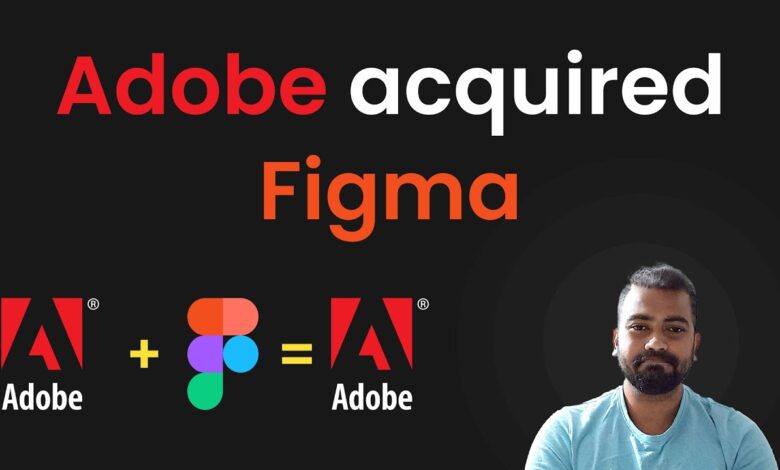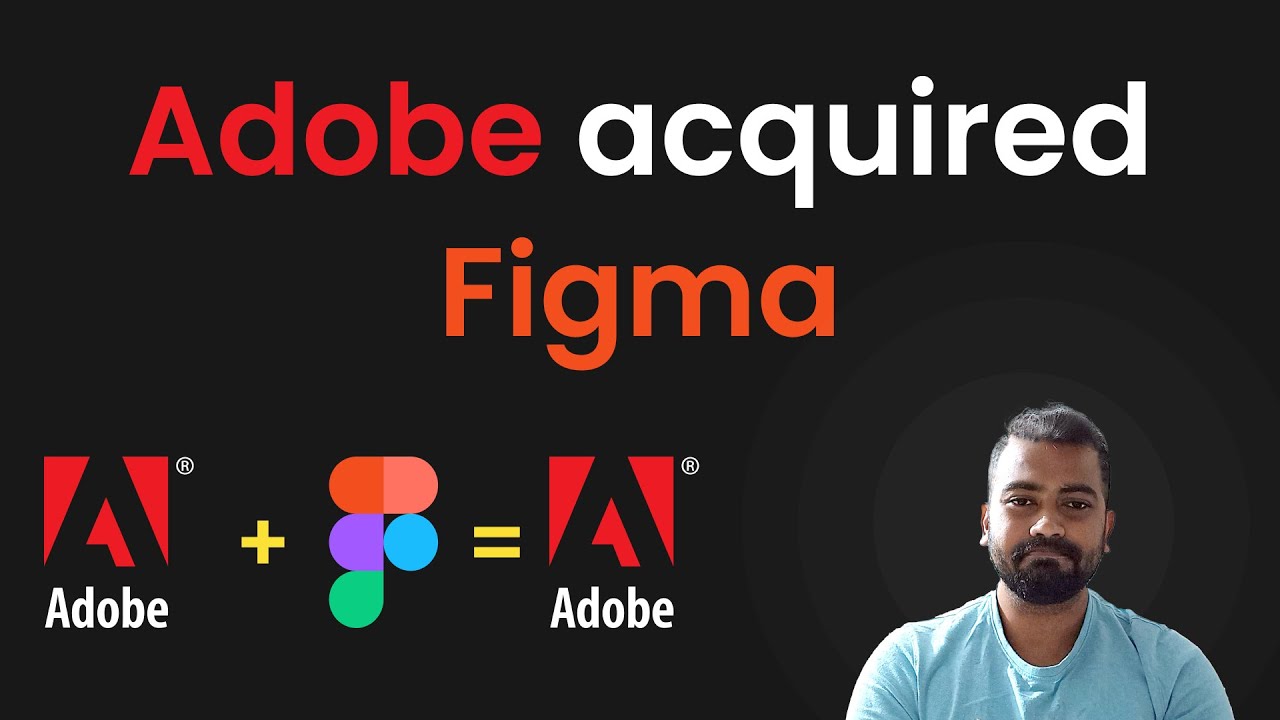
Adobe Buys Figma for 20 Billion Dollars
Adobe buys Figma for 20 billion dollars – that’s a headline that sent shockwaves through the design world! This massive acquisition isn’t just about a hefty price tag; it’s a seismic shift in the landscape of digital design tools. It signals a potential consolidation of power, raises questions about competition, and leaves designers everywhere wondering what the future holds.
Will this be a win-win for everyone, or will it lead to unforeseen consequences?
The sheer size of the deal is staggering, making it one of the largest tech acquisitions in recent history. This blog post will dive into the financial implications, the competitive dynamics, and the potential impact on both users and the industry as a whole. We’ll explore the integration challenges, the strategic reasoning behind Adobe’s move, and what this could mean for the future of design software.
The Deal’s Financial Implications
Adobe’s $20 billion acquisition of Figma represents a significant financial undertaking, impacting various aspects of the company’s balance sheet and future performance. The deal’s success hinges on realizing synergies and effectively integrating Figma’s operations, while navigating potential regulatory scrutiny.
Impact on Adobe’s Financial Statements
The acquisition will significantly increase Adobe’s assets by $20 billion, reflected as goodwill and other intangible assets on the balance sheet. This will simultaneously increase Adobe’s liabilities, depending on the funding method employed (discussed below). In the short term, we can expect to see a decrease in Adobe’s cash reserves. Long-term, the impact will depend on Figma’s profitability and the successful integration of the two companies.
Increased revenue streams from Figma’s user base, coupled with cost synergies, should ideally boost Adobe’s overall profitability over time. However, amortization of intangible assets related to the acquisition will likely impact earnings per share (EPS) in the coming years.
Adobe’s Stock Price: Short and Long-Term Effects
The immediate market reaction to the acquisition was mixed. While some analysts viewed it as a bold move to strengthen Adobe’s position in the design software market, others expressed concerns about the high acquisition price and potential integration challenges. In the short term, the stock price may fluctuate depending on investor sentiment and further details regarding the integration strategy.
The long-term effect will largely depend on the successful integration of Figma and the realization of the projected synergies. A successful integration, leading to increased revenue and market share, would likely result in a positive impact on Adobe’s stock price. However, failure to achieve these synergies could lead to a negative impact. Similar large acquisitions, such as Microsoft’s acquisition of LinkedIn, initially saw stock price volatility but ultimately saw long-term growth after successful integration.
Funding Methods for the Acquisition
Adobe likely employed a combination of financing methods to fund the $20 billion acquisition. This could include a significant portion from existing cash reserves, supplemented by debt financing through corporate bonds or bank loans. A potential issuance of new equity is also possible, though less likely given Adobe’s strong financial position. The specific mix of funding will depend on several factors, including Adobe’s risk tolerance, interest rates, and market conditions.
The chosen funding strategy will also influence the company’s long-term financial health and debt-to-equity ratio.
Synergies Between Adobe and Figma Leading to Increased Revenue
The acquisition offers significant synergy potential. Figma’s strong collaborative design platform can be seamlessly integrated with Adobe’s Creative Cloud suite, offering a more comprehensive and integrated design workflow. This could lead to increased user engagement and subscription revenue, as users may be more inclined to subscribe to a combined platform offering a broader range of tools. Furthermore, cross-selling opportunities arise, allowing Adobe to offer Figma’s collaborative features to existing Creative Cloud users and vice-versa.
Expansion into new markets and user segments is another potential revenue driver.
Hypothetical Financial Model: Projected ROI
Predicting the exact ROI of the acquisition is challenging, as it depends on numerous variables and assumptions. However, a simplified hypothetical model can illustrate potential outcomes. Let’s assume that Figma contributes an additional $2 billion in annual revenue within five years, with a net profit margin of 20%. This would translate to $400 million in annual net profit from Figma.
Assuming a discount rate of 10%, the present value of these future profits over five years would be approximately $1.5 billion. If we deduct the $20 billion acquisition cost, the net present value (NPV) would be negative. However, this is a simplified model. The actual ROI could be significantly higher if synergies lead to increased revenue from Adobe’s existing products and expansion into new markets.
The model should also consider potential cost savings from economies of scale and reduced marketing expenses. A more sophisticated model would incorporate detailed financial projections, including revenue growth, cost savings, and risk factors. The success of the acquisition ultimately hinges on Adobe’s ability to effectively integrate Figma, retain its user base, and expand its market reach.
Market Competition and Consolidation: Adobe Buys Figma For 20 Billion Dollars

Source: savemyleads.com
Adobe’s acquisition of Figma for a staggering $20 billion sent shockwaves through the design software industry. This monumental deal dramatically reshapes the competitive landscape, consolidating significant market power under Adobe’s umbrella and raising important questions about the future of design tools.The impact on the competitive landscape is profound. Before the acquisition, Adobe and Figma were arguably the two leading players, with Adobe holding a dominant share in professional design tools through its Creative Cloud suite (Photoshop, Illustrator, etc.), while Figma carved a substantial niche with its collaborative, browser-based approach, particularly popular among startups and rapidly growing teams.
The acquisition essentially eliminates Figma as a standalone competitor, leaving Adobe with a significantly larger market share. Precise figures are difficult to obtain, as market share data varies depending on the methodology used and the specific segment being considered (e.g., professional vs. amateur users, specific design disciplines). However, it’s safe to say Adobe’s already considerable dominance has been amplified considerably.
Adobe’s $20 billion acquisition of Figma is huge news for the design world, shaking things up considerably. It makes me wonder about the future of video tutorials, especially considering how crucial visual learning is – that’s why I’ve been diving into strategies for getting it on with youtube to explain complex design software. This Adobe-Figma deal definitely impacts how we’ll teach and learn about these tools in the coming years.
Antitrust Concerns and Implications
The sheer size of the acquisition immediately raised antitrust concerns. Regulators in the US and Europe are scrutinizing the deal, primarily concerned that Adobe’s near-monopoly in the professional design software market will stifle innovation and potentially lead to higher prices and reduced choice for consumers. The argument centers on whether Adobe’s acquisition eliminates a significant competitor that offered a viable alternative, thus reducing competition and potentially harming consumers.
The outcome of these investigations will be crucial in determining the long-term implications of the merger. If regulators deem the acquisition anti-competitive, they could impose remedies ranging from behavioral remedies (like restrictions on Adobe’s pricing or product development) to structural remedies (like forcing Adobe to divest parts of Figma). The precedent set by this case could significantly influence future mergers and acquisitions in the tech industry.
Influence on Pricing Strategies
The acquisition’s influence on Adobe’s pricing strategies is a key area of concern. With a significantly reduced competitive pressure, Adobe might be tempted to increase the prices of its existing products or bundle them in ways that are less favorable to consumers. Historically, Adobe has been criticized for its subscription-based pricing model, which some users find expensive. The absence of a strong competitor like Figma could potentially embolden Adobe to further increase prices or limit features in its products, particularly if it feels it can leverage its now expanded market share to do so.
The impact on pricing will depend largely on regulatory oversight and market response.
Comparison of Key Features: Figma vs. Adobe Design Tools
It’s crucial to compare the key features of Figma and Adobe’s existing design tools to understand the implications of the acquisition. The following table highlights some key differences:
| Feature | Figma | Adobe XD | Adobe Photoshop |
|---|---|---|---|
| Platform | Browser-based (web and desktop apps) | Desktop app (Windows, macOS) | Desktop app (Windows, macOS) |
| Collaboration | Real-time collaboration, strong emphasis on teamwork | Real-time collaboration, but less robust than Figma | Limited real-time collaboration; primarily individual use |
| Vector Editing | Excellent vector editing capabilities | Good vector editing capabilities | Industry-leading raster and vector editing capabilities |
| Prototyping | Robust prototyping features, including interactive components | Strong prototyping features | Prototyping capabilities are less developed |
Figma’s User Base and Integration

Source: bwbx.io
Adobe’s acquisition of Figma for a staggering $20 billion hinges significantly on successfully integrating Figma’s substantial and unique user base into the Adobe Creative Cloud ecosystem. This integration presents both immense opportunities and considerable challenges. Understanding the demographics of Figma’s users and developing a robust integration strategy are crucial for Adobe’s long-term success.Figma’s user base is notably diverse, encompassing a wide range of designers, from independent freelancers and small startups to large enterprise teams.
Unlike Adobe’s traditional user base, which is heavily weighted towards established professionals using desktop applications, Figma attracted a younger generation of designers, many of whom prefer browser-based collaborative tools and are more comfortable with cloud-based workflows. This difference in user profile necessitates a carefully considered approach to integration.
Figma User Demographics and Characteristics
Figma’s appeal lies in its collaborative features and browser-based accessibility, attracting users who value ease of use and real-time collaboration. A significant portion of its users are likely to be younger designers, comfortable with SaaS models and less entrenched in the traditional Adobe Creative Suite workflow. Many are likely to be involved in web design, UI/UX, and product design, with a strong preference for agile and iterative design processes.
Enterprise users represent a significant segment, leveraging Figma for its centralized design system management and streamlined team collaboration capabilities. The geographical distribution is likely globally diverse, reflecting the internet-based nature of the platform.
Strategies for Integrating Figma’s User Base
A phased approach to integration is essential. Initially, Adobe should focus on ensuring seamless functionality and compatibility. This might involve offering direct import/export capabilities between Figma and Adobe XD, Photoshop, and Illustrator. Furthermore, Adobe could offer attractive incentives, such as extended free trials or bundled subscriptions, to encourage migration. Crucially, maintaining Figma’s existing functionality and user experience is paramount to avoid alienating existing users.
Integration should be presented as an enhancement, not a forced migration. A robust and easily accessible support system will be crucial during this transition period. Adobe could also leverage its extensive educational resources and tutorials to help Figma users learn how to effectively utilize the expanded capabilities within the Adobe ecosystem. For enterprise clients, customized integration solutions and dedicated support teams might be necessary to ensure a smooth transition.
Challenges in Migrating Figma Users
The biggest challenge will be convincing existing Figma users, particularly those who chose Figma specificallybecause* it wasn’t Adobe, to adopt Adobe’s products. Many are deeply invested in Figma’s ecosystem and workflows. The transition could be perceived as disruptive and inconvenient, potentially leading to user churn. Another challenge is the potential for friction between existing Adobe users and newly integrated Figma users, especially regarding workflows and design philosophies.
Addressing potential compatibility issues between Figma files and Adobe’s file formats will be critical. Ensuring that the integration doesn’t compromise Figma’s performance or collaborative capabilities will also be paramount. Finally, managing user expectations and addressing concerns about data security and privacy will be crucial to maintaining trust and loyalty.
Maintaining Figma’s Brand Identity and User Experience
Preserving Figma’s brand identity and user experience is vital for retaining its user base. Adobe should avoid drastic changes to the interface or functionality. Instead, the focus should be on gradual integration and enhancements, ensuring a smooth transition for existing users. This might involve incorporating Figma’s intuitive design principles into other Adobe products, rather than forcing Figma users to adapt to a completely new workflow.
Maintaining open communication with the Figma community and actively soliciting feedback will be crucial for managing expectations and addressing concerns. Adobe should commit to long-term support for Figma and its community, demonstrating a genuine commitment to the platform’s continued growth and development.
Leveraging Figma’s Collaborative Features
Figma’s real-time collaboration capabilities offer a significant opportunity for Adobe to enhance its existing products. Integrating these features into Adobe XD, Photoshop, and Illustrator could significantly improve team workflows and facilitate real-time feedback and collaboration. This could be particularly beneficial for large design teams working on complex projects. Imagine a scenario where multiple designers could simultaneously work on a Photoshop file, with changes visible in real-time to all collaborators.
This level of seamless collaboration could redefine how design teams operate, fostering increased efficiency and productivity. This integration could also facilitate better communication and reduce the need for cumbersome version control systems. Furthermore, Adobe could leverage Figma’s community features to foster a more vibrant and interconnected design community across its entire platform.
Impact on Designers and the Design Industry
The Adobe acquisition of Figma, a monumental deal in the design software landscape, will undoubtedly reshape how designers work and the overall design industry. This merger brings together two giants, each with its strengths and loyal user bases, creating both exciting possibilities and potential challenges for designers worldwide. The impact will be felt across workflows, pricing, accessibility, and the pace of innovation.The acquisition’s effects on designers’ workflows are multifaceted.
Figma’s collaborative, browser-based platform is popular for its real-time editing and ease of use, particularly among teams. Adobe’s extensive suite of creative tools, including Photoshop, Illustrator, and XD, caters to a broader range of design needs. The integration of these platforms could streamline workflows, offering seamless transitions between different stages of the design process. However, this integration also carries the risk of disrupting established workflows and potentially requiring designers to adapt to new interfaces and processes.
For example, designers accustomed to Figma’s specific collaborative features might need to learn new ways of working within the Adobe ecosystem.
Changes in the Design Industry Following the Merger
The merger could lead to significant shifts in the design industry. One potential change is increased consolidation, with Adobe potentially becoming a dominant force, influencing market trends and setting industry standards. This could lead to less diversity in design software and potentially limit innovation from smaller, independent players. Another significant change could be the alteration of design education. Curriculum may need to adapt to reflect the integration of Figma’s features into the Adobe Creative Cloud, potentially requiring updates to teaching materials and training programs.
The long-term impact on the education of future designers will depend on how Adobe chooses to integrate Figma into its existing educational offerings and how educational institutions respond to this shift.
Pricing and Accessibility of Design Software, Adobe buys figma for 20 billion dollars
The impact on pricing and accessibility is a major concern. While Adobe currently offers a subscription-based model, Figma’s free plan has attracted many hobbyists and smaller teams. The integration might lead to changes in pricing structures, potentially making professional-grade design tools less accessible to individuals or small businesses that relied on Figma’s free or low-cost options. This could exacerbate existing inequalities within the design community, potentially widening the gap between established professionals and aspiring designers.
A similar situation occurred with the consolidation in the video editing market where previously affordable options became more expensive and less accessible.
Potential for Increased Innovation in Design Tools
Conversely, the acquisition could also fuel innovation. Adobe’s resources combined with Figma’s innovative approach to collaborative design could lead to the development of more powerful and user-friendly design tools. For example, we could see improvements in AI-powered design features, enhanced collaboration tools, and more seamless integration with other creative applications. The potential for advancements in areas like real-time collaboration, AI-assisted design, and 3D modeling is substantial.
This potential for innovation depends heavily on Adobe’s strategic direction and its commitment to maintaining and improving Figma’s unique features.
Benefits and Drawbacks for Designers
The impact on designers is complex and presents both advantages and disadvantages. It’s crucial to weigh these carefully.
- Potential Benefits:
- Streamlined workflows through better integration between Figma and other Adobe products.
- Access to a wider range of design tools and features within a single ecosystem.
- Potential for enhanced collaboration tools and improved real-time editing capabilities.
- Increased innovation and development of new design tools driven by combined resources.
- Potential Drawbacks:
- Potential increase in subscription costs, reducing accessibility for some designers.
- Disruption of existing workflows and the need to adapt to new interfaces and processes.
- Reduced competition and potential for less innovation in the overall design software market.
- Concerns about data privacy and the consolidation of user data under a single entity.
Long-Term Strategic Goals

Source: websitebuildertutorials.org
Adobe’s acquisition of Figma, a monumental $20 billion deal, isn’t just about adding another product to their portfolio; it’s a strategic maneuver designed to solidify their position as the dominant force in the creative software landscape and propel them into new, rapidly expanding markets. This acquisition reflects a long-term vision that extends beyond immediate market share gains.The acquisition directly addresses Adobe’s need to strengthen its presence in the collaborative design space, a market segment experiencing explosive growth.
Figma’s browser-based, collaborative platform complements Adobe’s existing desktop-centric applications, creating a comprehensive suite catering to both individual designers and large collaborative teams. This synergy allows Adobe to offer a complete design workflow, from initial ideation to final production, appealing to a wider audience and fostering greater user loyalty. This is crucial for Adobe’s long-term growth, as it ensures they remain relevant and competitive in an evolving technological landscape.
Adobe’s Strategic Rationale
Adobe’s rationale for acquiring Figma centers on several key strategic objectives. Firstly, it addresses the growing threat posed by Figma’s collaborative platform, preventing a potential competitor from gaining significant market share. Secondly, the acquisition provides Adobe with access to Figma’s innovative technology, including its real-time collaboration features and vector-based design capabilities, which can be integrated into existing Adobe products like Photoshop and Illustrator, enhancing their functionality and user experience.
Finally, Figma’s strong user base, particularly amongst younger designers and startups, introduces Adobe to a new generation of creative professionals, ensuring the longevity of their brand and influence.
Future Acquisitions and Partnerships
Following the Figma acquisition, Adobe is likely to pursue strategic acquisitions and partnerships that complement Figma’s capabilities and further expand its creative ecosystem. Potential targets could include companies specializing in 3D modeling, animation, or artificial intelligence-powered design tools. Partnerships with cloud infrastructure providers and other software companies could also enhance the integration and scalability of Adobe’s offerings. For example, a partnership with a leading cloud rendering service could significantly improve the performance of Adobe’s 3D design tools, leveraging Figma’s collaborative features for real-time feedback and collaboration on complex 3D projects, similar to how Autodesk has integrated cloud rendering into its software.
Expansion into New Markets and Product Categories
Figma’s technology opens doors for Adobe to expand into new markets and product categories. The browser-based nature of Figma’s platform allows for easier accessibility and integration across various devices and operating systems, potentially leading to the development of new mobile design tools or applications for emerging technologies like augmented and virtual reality. The collaborative features of Figma could also be leveraged to create new tools for team-based projects in areas beyond graphic design, such as user interface (UI) and user experience (UX) design for software development, product design, and even architectural visualization.
This diversification reduces reliance on any single market segment and strengthens Adobe’s long-term resilience.
Potential Future Product Roadmap
A visual representation of Adobe’s potential future product roadmap incorporating Figma’s capabilities could be a concentric circle diagram. The central circle represents the core Adobe Creative Cloud applications (Photoshop, Illustrator, InDesign, etc.). The next concentric circle would showcase the integration of Figma’s collaborative features and real-time co-editing capabilities across these core applications. The outermost circle would depict new product categories and markets that Adobe could enter leveraging Figma’s technology, such as dedicated mobile design apps, 3D modeling tools enhanced by Figma’s collaboration features, and AI-powered design assistance tools integrated across the entire suite.
Each circle would be color-coded to represent different product categories or functionalities, with connecting lines illustrating the seamless integration and flow of information between different applications and services. This visual would clearly communicate the synergistic effect of the Figma acquisition on Adobe’s overall product strategy, showcasing its potential to unify and expand its offerings across various design disciplines and platforms.
End of Discussion
The Adobe-Figma acquisition is a game-changer, a bold move that will undoubtedly reshape the design software market for years to come. While the long-term effects remain to be seen, one thing is certain: the world of digital design just got a whole lot more interesting. Whether this leads to increased innovation, a more streamlined workflow for designers, or potential antitrust concerns remains to be seen.
Only time will tell the full story of this massive deal and its lasting impact.
Essential FAQs
Will Figma still exist as a separate product?
Adobe has stated its intention to maintain Figma as a separate brand and product, at least for the foreseeable future. However, integration with Adobe’s Creative Cloud is expected.
What will happen to Figma’s pricing?
This is currently unknown. Adobe may choose to integrate Figma’s pricing into its Creative Cloud offerings, potentially altering current pricing structures for both platforms.
What about competition from other design tools like Sketch or XD?
This acquisition significantly reduces competition, potentially leading to less innovation from other players in the market and potentially higher prices in the long run.
How will this affect the design community?
The impact is complex. Some designers may welcome the integration with other Adobe tools, while others may be concerned about potential changes to Figma’s user experience or pricing. Time will tell how the community adapts.
